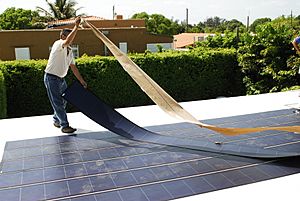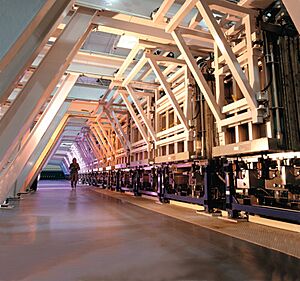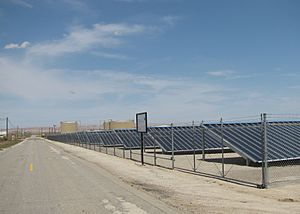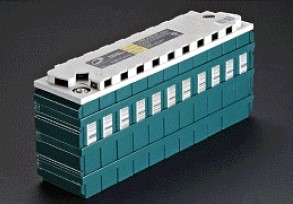Energy Conversion Devices facts for kids
| Public | |
| Traded as | NASDAQ: ENER (2003–2012) |
| Industry | Alternative energy |
| Fate | Bankruptcy |
| Founded | 1960 |
| Founder | Stanford R. Ovshinsky |
| Defunct | 2012 |
| Headquarters |
,
United States
|
Energy Conversion Devices, Inc. (ECD) was an American company that made special solar panels. These panels were thin and flexible, often used on roofs or built into buildings. ECD also made rechargeable batteries and other products that helped create clean energy. The company was based in Rochester Hills, Michigan.
ECD had a company called United Solar Ovonic, LLC, also known as Uni-Solar. This company was once the biggest maker of flexible solar panels in the world. Uni-Solar panels were long strips that could be glued onto many surfaces. They were popular on flat roofs, motorhomes, and truck cabs.
Sadly, on February 14, 2012, Energy Conversion Devices, Inc. and its related companies went out of business.
Contents
What Energy Conversion Devices Did
Energy Conversion Devices, Inc. (ECD) focused on solar power for buildings. They made and installed thin, flexible solar panels. These panels turned sunlight into electricity.
The company had two main parts. One part, United Solar Ovonic (USO), made solar panels that could be part of roofing materials. The other part, Ovonic Materials, invented new materials and products. These inventions were based on ECD's special science. ECD worked on clean energy, energy storage, and computer technology.
Ovonics is a special type of electronics. It uses materials that can change from not conducting electricity to conducting it. This happens when a certain amount of voltage is applied. A key example is a type of computer memory called phase change memory.
A scientist and business owner named Stanford R. Ovshinsky started this field. He also created the name "Ovonics." He founded Energy Conversion Devices, Inc. (ECD) in 1960. His goal was to research special materials called amorphous semiconductors. ECD Ovonics worked to create energy sources that would not pollute or harm the climate.
Here are some key facts about Energy Conversion Devices, Inc. (ECD):
- It was a major maker of flexible solar panels.
- It worked on NiMH batteries, ways to store hydrogen fuel, and solar power.
- The founder, Stanford Ovshinsky, was called a "Hero for the planet" by Time magazine in 1999. He also joined the U.S. Solar Energy Hall of Fame in 2005.
How the Company Was Organized
ECD Ovonics had different parts and owned other companies.
- Energy Generation
- United Solar Ovonic Corp (100% owned): This company made flexible photovoltaic laminates (solar panels).
- Solar Integrated, Inc. (100% owned): This company handled solar installations. It designed systems, managed construction, and took care of maintenance.
- Ovonic Fuel Cell Company LLC (100% owned)
- Energy Storage
- Information Technology
- Ovonic Media (100% owned)
- Ovonyx Inc. (39.5% owned by ECD)
- Ovonic Cognitive Computer (95% owned by ECD, 5% by Ovonyx)
United Solar Ovonic Corporation
The United Solar Ovonic Corporation was once the world's largest maker of flexible solar panels in 2008. These solar cells were made of 11 layers of amorphous silicon. They could turn 11-13% of sunlight into electricity. The panels were covered with a strong, clear material called ETFE. These panels were sold under the name "UNI-SOLAR".
The main factory and offices were in Auburn Hills, Michigan. A second factory was built in Greenville, Michigan, in 2007. Many of these solar panels were sold to companies that made metal roofs or special roof membranes. Flexible, thin-film solar products were also made for use in space.
Solar Integrated, Inc.
Solar Integrated, Inc. was a company fully owned by Energy Conversion Devices, Inc. This company handled the entire process of installing Uni-Solar products. This included designing the systems, buying materials, building, and maintaining the solar setups.
Ovonic Batteries
Ovonic nickel–metal hydride (NiMH) batteries were used in early electric cars. These included the 1998 Chevrolet S-10 EV and the 1999 General Motors EV1. They were also used in many hybrid vehicles that are still on the road today.
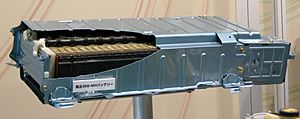
These batteries were also used in a special vehicle called an auto rickshaw. This vehicle burned hydrogen as fuel. A report said its performance was similar to vehicles that use natural gas.
Battery Ownership and Use
In 1994, General Motors gained control over Ovonics' battery work. This included patents for making large nickel metal hydride (NiMH) batteries.
Later, in 2000, Texaco bought General Motors' share in GM Ovonics. Then, Chevron bought Texaco. In 2003, Texaco Ovonics Battery Systems became Cobasys. This was a joint company owned equally by Chevron and Energy Conversion Devices (ECD) Ovonics.
Chevron had a big say in what Cobasys did with its battery technology. It could stop any sale or licensing of the NiMH technology. Chevron also had the right to take all of Cobasys's ideas if ECD Ovonics did not meet its agreements.
Some people believed that large NiMH batteries were good for electric cars. However, Cobasys would only sell them in very large orders. This made it hard for smaller companies or individuals to get these batteries.
In 2006, Cobasys and General Motors agreed that Cobasys would provide NiMH batteries for the Saturn Aura hybrid car. This car was later stopped. In 2007, General Motors also planned to use Cobasys batteries in the 2008 Chevrolet Malibu hybrid.
In 2009, a company called SB LiMotive bought Cobasys. This company was a joint venture between Samsung and Bosch. Later, it became part of Bosch.
In February 2012, ECD sold its Ovonic Battery Company to BASF Corporation.
Images for kids
See also


